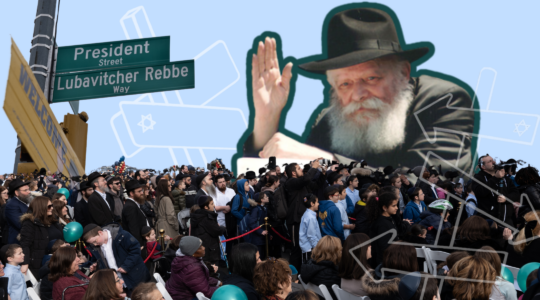Designer of handbags beloved by society women and first ladies, Judith Leiber will get her own major retrospective.
Opening in April, The Museum of Arts and Design (MAD) in Columbus Circle will present “Crafting a New York Story,” an exhibit telling Leiber’s unique life story. Known for expert craftsmanship, high-quality materials and witty designs, her handbags have been in demand since she began making them in Budapest in the 1940s.
Born Judith Peto in Budapest in 1921, Leiber wanted to be a chemist and create a line of skincare products. She began her studies at King’s College in London in 1938, but when she came home for summer break in 1939, war had broken out, and she was unable to return.
She changed course, and decided to learn how to make handbags. She studied at the well-known company Pessl, becoming its first female apprentice, and went on to become the first woman master in the Hungarian Handbag Guild, which remained open to Jews during the war.
Leiber began her stint in the Guild sweeping the floors and cooking the glue. “There was a stricture against Jews, mostly to keep us out of important positions and upper classes things. Making handbags was not considered very upper class,” she said in “The Artful Handbag,” a book about her life and work.
“Hitler put me in the handbag business,” she has said.
The Peto family managed to survive the Holocaust by living in a Jews-only designated house in Budapest’s Jewish ghetto. Living in the basement, with numerous other people, the family ate whatever food it could obtain, first under the Nazis, then under the Soviets. Leiber has said that at times during the war when she wasn’t able to work, she continued to design bags in her imagination.
As the war was ending, she met Gerson Leiber, an aspiring artist who was in Budapest with the American army’s Signal Corps. Leiber was able to make inroads with the American military community in Budapest and sell purses to employees of the American Embassy.
Judith and Gerson married in 1946 and Judith came to New York on a brides’ ship, bringing along her box of handbag tools, which remains in her possession to this day.
In New York, Gerson studied art while Judith found work making bags. At first, Leiber was dismayed that the company that employed her was not innovative, copied European designs and relied heavily on machines. She was soon able to move to Nettie Rosenstein’s more prestigious company, where she worked her way up from assistant patternmaker to designer. When First Lady Mamie Eisenhower wore a Judith Leiber-designed Nettie Rosenstein purse to the inauguration ball, a large spotlight suddenly shone on Leiber’s work.
With Gerson’s help and encouragement, Leiber started her own business in 1963 and went on to become a multiple award-winning designer. With growing success, the company expanded until it was a four-floor operation with over 200 employees.
Leiber is best known for her minaudieres, her small, fancifully shaped purses covered in Swarovski crystals. Making a Judith Leiber bag can mean a 10-day project, from constructing the frame to laying the tiny stones covering the facade. The beaded handbags require between 7,000 and 13,000 Swarovski rhinestones, each applied by hand with jeweler’s tweezers. The minaudieres, all handmade, can last for decades.
Leiber’s elegant minaudieres come in whimsical shapes such as a penguin, a stalk of asparagus, even a cello. They are designed to be just big enough for a credit card, a $100 bill and a lipstick, and are coveted among wealthy women who may buy them as often as once a year or to mark special occasions. First Ladies from Jacqueline Kennedy to Hillary Clinton wore Leiber’s intricate handbags.
Some women consider their Leiber purses to be more than a practical accessory but a type of jewelry that is a pleasure to behold and touch. Others treat the purses as functional sculptures and display them in their homes when they’re not in use. Some think of them as modern-day Faberges.
Leiber sold her eponymous company in 1993, and stayed on as a consultant until her retirement in 1997. Throughout her career, she designed over 3,500 purses. In 2005, she and Gerson, now both in their 90s, opened East Hampton’s Leiber Collection, which has about 1,000 handbags in inventory .
None of Leiber’s handbags from Budapest survived, so the MAD show will focus on Leiber’s New York oeuvre. Leiber’s design process was fairly minimalistic; she didn’t keep a sketchbook or make any drawings, but just worked out the designs on the materials as she went. On display will be six wax models carved by a sculptor, which were used to create the molds for the minaudìeres.
“Crafting a New York Story” will be organized around a number of thematic narratives featuring Leiber as a craftswoman, designer and immigrant entrepreneur; the evolution of the handbag in 20th-century Western fashion; the gendered nature of the handbag (vs. pockets); the importance of arts and culture on Leiber’s work; and the Leiber minaudìeres as carried by celebrities and first ladies.
“It’s my hope,” noted curator Samantha De Tillio in an email interview, “that the exhibition will help expand the frame of reference for her work, creating entry points for new viewers who are not familiar with it and who find a common ground either through the immense creativity and craftsmanship of her handbags, or through her personal story of immigration, entrepreneurship and feminist drive.” ✿
“Judith Leiber: Crafting a New York Story” will be on view at the Museum of Arts and Design April 4-Aug. 6, madmuseum.org.
The New York Jewish Week brings you the stories behind the headlines, keeping you connected to Jewish life in New York. Help sustain the reporting you trust by donating today.




